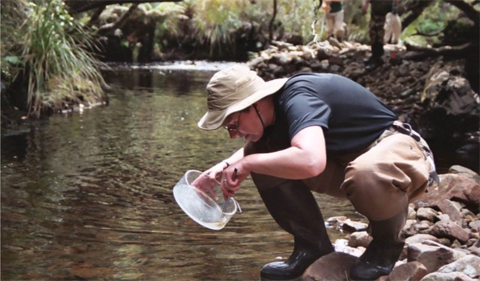Danny Wolf ’18M.S., a graduate student in Environmental & Plant Biology at Ohio University, won the Harold C. Bold Award for outstanding graduate student presentation at the Phycological Society of America’s annual meeting in Vancouver, Canada July 29 to Aug. 2.
Wolf presented his thesis research, titled “Multi-marker Metabarcoding Assessment of Biodiversity within Stream Biofilm Communities along an Acid Mine Drainage Recovery Gradient.” In April, Wolf won best student presentation at the Northeast Algal Symposium, and that provided funding for him to attend and present at the Phycological Society conference.
Wolf graduated this summer and is pursuing a career in bioinformatics.
Abstract: In southeastern Ohio, active remediation of streams affected by Acid Mine Drainage (AMD) has proven to be successful for some streams, while others have not recovered based on macroinvertebrate assessment. In this study, biofilms were collected from three Not Recovered, three Recovered, and two Unimpaired streams. The biodiversity was characterized by metabarcoding using two universal barcode markers (16S & 18S) along with two algal specific markers (UPA & rbcL) and high-throughput amplicon sequencing. For each marker, the ordination of Bray-Curtis Index calculated from the total operational taxonomic units (OTUs) present in each stream showed the Unimpaired and Recovered streams clustered, while Not Recovered streams were more distant. Focusing on the algal OTUs only, the Shannon index for the rbcL and UPA markers showed significantly lower alpha diversity in Not Recovered streams compared to Unimpaired streams, but the Recovered streams were not significantly different from the other two stream types. Further examination of the UPA marker revealed a decrease in relative abundance of diatoms in Not Recovered streams compared to Recovered and Unimpaired streams. The same 10 algal phyla were identified with the 18S and UPA marker, but the UPA included Cyanobacteria as well. A total of 21 diatom genera were identified from the rbcL marker data and these were investigated for taxa that have been reported to be indicators of high water quality. Overall, results from this study corroborate previous findings using individual groups of organisms to assess stream impairment from AMD.
In addition to Wolf’s presentation, Dr. Morgan Vis, Professor of Environmental and Plant Biology, presented a poster titled “Synthesis of Freshwater Red Algal Diversity (Rhodophyta).”
Abstract: Since the advent of molecular systematics studies of freshwater red algae, the results have necessitated taxonomic changes. Within the Batrachospermales, rectifying the paraphyly of Batrachospermum has been a focus. New genera have been proposed to accommodate subgeneric sections as well as clades without previous section designation. These ‘Batrachospermum-like’ genera include Atrophycus, Lympha, Nocturama, Sheathia, Virescentia, and Volatus. Nothocladus has been expanded to include most species from Australasia. In the near future, it is likely that six more genera will be proposed to complete the task of rendering Batrachospermum monophyletic. Although this genus has been shrinking due to the description of these new genera, four new species have been added to Batrachospermum sensu stricto. Recently, the diversity in Thorea has expanded with at least nine species recognized from DNA sequence data and potentially 17 species based on the literature. Outside of these strictly freshwater orders, there have been two notable recent discoveries. In the Corallinales, Pneophyllum cetinaensis is a new crustose species discovered in a freshwater habitat even though all other species are marine. Within the Acrochaetiales, a new family and genus have been described for a red algal endophyte, Ottia meiospora from Australasia. The systematics of the freshwater red algae have been dynamic in recent years and this trend will continue in the near future. However, we have a new book project underway to synthesize these new developments and provide a comprehensive treatment of this charismatic group of organisms.




















Comments